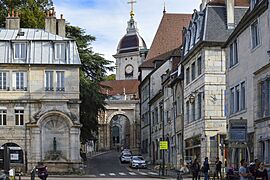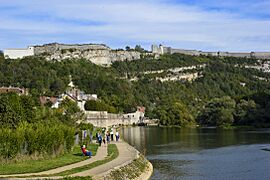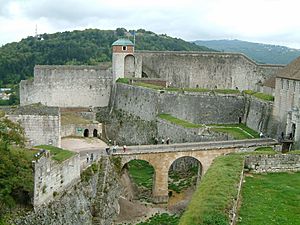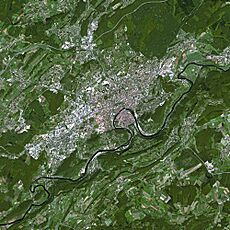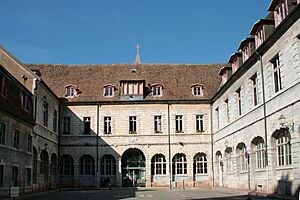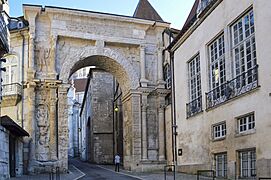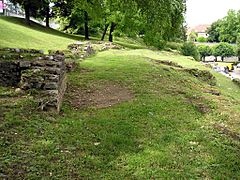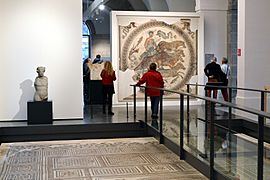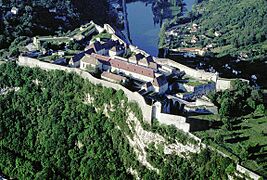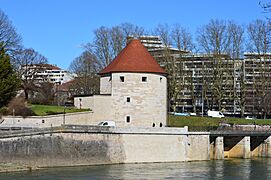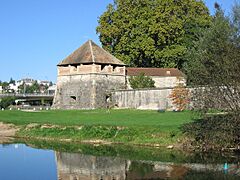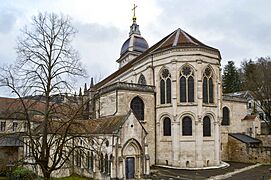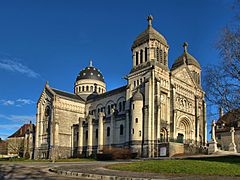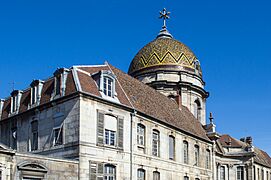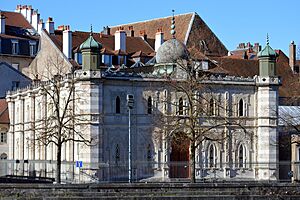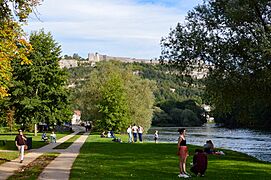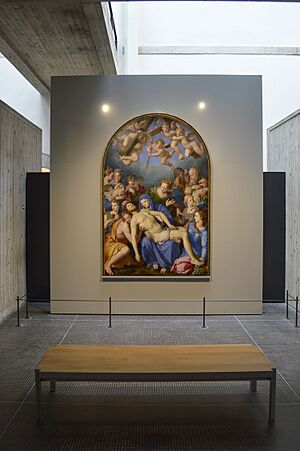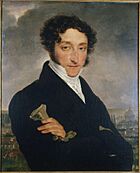Besançon facts for kids
Quick facts for kids
Besançon
|
|||
|---|---|---|---|
|
Prefecture and commune
|
|||
|
Left to right, top to bottom: the Saint-Jean district with the Porte Noire and the cathedral, the town hall, the Granvelle Palace, Quai Vauban, citadel abobe the river Doubs.
|
|||
|
|||
| Motto(s):
Plût A Dieu ("If God wills") or Utinam
|
|||
| Country | France | ||
| Region | Bourgogne-Franche-Comté | ||
| Department | Doubs | ||
| Arrondissement | Besançon | ||
| Canton | Besançon-1, 2, 3, 4, 5 and 6 | ||
| Intercommunality | Grand Besançon Métropole | ||
| Area
1
|
65.05 km2 (25.12 sq mi) | ||
| • Urban
(2021)
|
528.6 km2 (204.1 sq mi) | ||
| • Metro
(2021)
|
2,514.5 km2 (970.9 sq mi) | ||
| Population
(2021)
|
119,198 | ||
| • Rank | 33rd in France | ||
| • Density | 1,832.41/km2 (4,745.9/sq mi) | ||
| • Urban
(2021)
|
197,494 | ||
| • Urban density | 373.62/km2 (967.66/sq mi) | ||
| • Metro
(2021)
|
283,127 | ||
| • Metro density | 112.5977/km2 (291.627/sq mi) | ||
| Time zone | UTC+01:00 (CET) | ||
| • Summer (DST) | UTC+02:00 (CEST) | ||
| INSEE/Postal code |
25056 /25000
|
||
| 1 French Land Register data, which excludes lakes, ponds, glaciers > 1 km2 (0.386 sq mi or 247 acres) and river estuaries. | |||
Besançon is a city in eastern France. It is the main city of the Doubs area in the Bourgogne-Franche-Comté region. The city is located near the Jura Mountains and the border with Switzerland.
Besançon is the historic capital of the Franche-Comté region. It is an important center for government and the military in the area. In 2021, about 119,198 people lived in the city. The larger metropolitan area had 283,127 residents.
The city sits in a bend of the Doubs river. It was an important place even in Roman times, known as Vesontio. Its location and history made it a strong military base and a key political and religious center.
Besançon is famous for making watches in France. Today, it is a hub for new technologies like microtechnology, micromechanics, and biomedical engineering. The University of Franche-Comté was founded in 1423. It welcomes nearly 30,000 students each year. About 4,000 of these are international students learning languages at its Centre for Applied Linguistics.
Besançon is known as a very green city in France. People say it has a great quality of life. Since 1986, it has been called a "Town of Art and History". Its old forts, designed by Vauban, are a UNESCO World Heritage Site since 2008.
Contents
A Look at Besançon's Past
How Besançon Got Its Name
The city was first mentioned in 58 BC as Vesontio. This was in a book by Julius Caesar about his wars in Gaul. The name Vesontio might come from a Celtic word meaning 'mountain'. Around the 4th century, the name changed to Besontio or Bisontion. By 1243, it became Besançon. People from Besançon are still called Bisontins today.
Besançon in Ancient Times

The city is built inside a big loop of the Doubs river. A mountain closes off one side. Around 1500 BC, during the Bronze Age, Gaulish tribes settled here.
From the 1st century BC, the city was very important for military reasons. This was because the Alps mountains rise sharply to its south, creating a natural barrier.
The Sequani tribe built a strong town called Vesontio here. It helped them control trade routes. Julius Caesar described Vesontio as the largest town of the Sequani. He said it was surrounded by a wooden fence.
Besançon in the Middle Ages

In 843, the Treaty of Verdun split up Charlemagne's empire. Besançon became part of a region called Lotharingia.
From 1034, Besançon was part of the Holy Roman Empire. In 1184, it became a Free Imperial City of Besançon. This meant it was an independent city-state under the Holy Roman Emperor. The Archbishops of Besançon became powerful princes in 1288. In 1290, the city gained full independence from the archbishops.
Besançon in the Renaissance and Later
In the 15th century, the dukes of Burgundy had influence over Besançon. Later, the city came under the control of the Habsburg family. In 1519, Charles V, Holy Roman Emperor, who was also King of Spain, became the Holy Roman Emperor. This made him ruler of Besançon and the surrounding region.
When Charles V stepped down in 1555, he gave the region to his son, Philip II of Spain. Besançon remained a free city, but under Spain's protection. In 1667, Louis XIV of France claimed the region.
Louis XIV captured the city in 1668. But a treaty soon gave it back to Spain. During this time, a famous military engineer named Vauban visited Besançon. He made plans to build strong defenses for the city. The Spanish then built the main fortress, "la Citadelle," following Vauban's ideas.
In 1674, French troops took the city again. The Treaty of Nijmegen in 1678 officially gave Besançon to France. The city then became the main administrative center for the region. Vauban continued to work on the city's defenses until 1711. Many forts were built on the hills around the city, like Fort de Trois Châtels and Fort Chaudanne. The Citadel itself has strong walls and moats. Today, the lit-up Citadel is a symbol of the city and Vauban's skill.
Besançon in Modern Times
In 1814, the Austrians attacked the city. Besançon was also important during the Franco-Prussian War of 1870–71.
During World War II, the Nazis used the citadel. They executed many French resistance fighters there. Besançon did not see much fighting during the war. The Allies bombed the railway in 1943. In 1944, the Germans fought the U.S. advance for four days.
From 1940 to 1941, the Germans also set up an internment camp in Besançon. It held about 3,000-4,000 British women and children. Conditions were very hard.
In 1959, the French Army gave the citadel to the city. It was then turned into a museum.
Besançon's Location and Landscape
Where is Besançon?
Besançon is in the northeast of France, on the Doubs river. It is about 325 kilometers (202 miles) east of Paris. It is also close to Dijon, Lausanne (Switzerland), and Belfort. The city is at the edge of the Jura Mountains.
The City's Shape
The city first grew in a large bend of the Doubs river. This loop is almost 1,000 meters (3,280 feet) wide. The flat area inside the loop is about 250 meters (820 feet) high. To the south, there is a hill called Mont Saint-Étienne, which is 371 meters (1,217 feet) high. Six other hills surround the city, ranging from 400 to 500 meters (1,312 to 1,640 feet) high.
Besançon's Weather
Besançon has an oceanic climate. This means it has cool to cold winters and warm summers. It rains often throughout the year. The average temperature for the year is 11.4°C (52.5°F). July is the warmest month, averaging 20.2°C (68.4°F). January is the coldest, averaging 2.9°C (37.2°F). Besançon gets about 1,157 millimeters (45.6 inches) of rain each year.
| Climate data for Besançon, elevation: 307 m (1,007 ft), 1991–2020 normals, extremes 1884–present | |||||||||||||
|---|---|---|---|---|---|---|---|---|---|---|---|---|---|
| Month | Jan | Feb | Mar | Apr | May | Jun | Jul | Aug | Sep | Oct | Nov | Dec | Year |
| Record high °C (°F) | 18.6 (65.5) |
21.7 (71.1) |
25.1 (77.2) |
29.1 (84.4) |
32.2 (90.0) |
36.6 (97.9) |
40.3 (104.5) |
38.3 (100.9) |
34.6 (94.3) |
30.1 (86.2) |
23.0 (73.4) |
20.8 (69.4) |
40.3 (104.5) |
| Mean daily maximum °C (°F) | 5.8 (42.4) |
7.6 (45.7) |
12.1 (53.8) |
16.1 (61.0) |
19.9 (67.8) |
23.6 (74.5) |
25.7 (78.3) |
25.5 (77.9) |
21.0 (69.8) |
16.1 (61.0) |
10.0 (50.0) |
6.4 (43.5) |
15.8 (60.4) |
| Daily mean °C (°F) | 2.9 (37.2) |
3.9 (39.0) |
7.5 (45.5) |
10.6 (51.1) |
14.6 (58.3) |
18.2 (64.8) |
20.2 (68.4) |
20.0 (68.0) |
16.0 (60.8) |
11.9 (53.4) |
6.9 (44.4) |
3.7 (38.7) |
11.4 (52.5) |
| Mean daily minimum °C (°F) | 0.1 (32.2) |
0.2 (32.4) |
3.0 (37.4) |
5.6 (42.1) |
9.4 (48.9) |
12.9 (55.2) |
14.7 (58.5) |
14.5 (58.1) |
11.1 (52.0) |
7.7 (45.9) |
3.5 (38.3) |
0.9 (33.6) |
7.0 (44.6) |
| Record low °C (°F) | −20.7 (−5.3) |
−20.6 (−5.1) |
−14.0 (6.8) |
−5.2 (22.6) |
−2.4 (27.7) |
2.1 (35.8) |
4.5 (40.1) |
3.4 (38.1) |
−0.1 (31.8) |
−6.1 (21.0) |
−11.3 (11.7) |
−19.3 (−2.7) |
−20.7 (−5.3) |
| Average precipitation mm (inches) | 89.7 (3.53) |
81.2 (3.20) |
85.0 (3.35) |
86.6 (3.41) |
107.9 (4.25) |
97.5 (3.84) |
88.8 (3.50) |
96.1 (3.78) |
100.7 (3.96) |
111.7 (4.40) |
106.5 (4.19) |
105.3 (4.15) |
1,157 (45.55) |
| Average precipitation days (≥ 1.0 mm) | 12.8 | 11.4 | 11.1 | 10.4 | 12.6 | 9.9 | 10.4 | 9.7 | 9.3 | 12.1 | 12.5 | 13.9 | 136.2 |
| Average relative humidity (%) | 87 | 82 | 77 | 74 | 77 | 77 | 75 | 78 | 82 | 87 | 87 | 88 | 81 |
| Mean monthly sunshine hours | 68.4 | 96.8 | 152.8 | 183.8 | 203.0 | 230.8 | 248.7 | 237.2 | 183.6 | 131.6 | 74.9 | 56.2 | 1,872.5 |
| Source 1: Meteo France | |||||||||||||
| Source 2: Infoclimat.fr (relative humidity 1961–1990) | |||||||||||||
Besançon's Neighborhoods
|
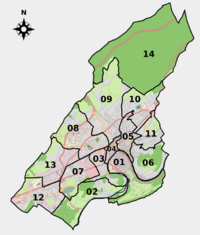 |
|
Besançon has 14 main neighborhoods:
- La Boucle
- Battant
- Bregille
- Les Clairs-Soleils
- Velotte
- La Butte
- Les Chaprais
- Palente
- Les Tilleroyes
- Montrapon
- Planoise
- Saint-Claude
- Saint-Ferjeux
- Chailluz
Besançon's Population
In 2021, Besançon had a population of 119,198 people. It is the 33rd largest city in France. The wider metropolitan area, called Grand Besançon Métropole, covers 528.6 square kilometers (204.1 sq mi). It includes 68 towns and has a population of 197,494. The even larger metropolitan area covers 2,514.5 square kilometers (970.9 sq mi) and has 283,127 people. The population grew by 4.9% between 2008 and 2020.
| Historical population | ||||||||||||||||||||||||||||||||||||||||||||||||||||||||||||||||||||||||||||||||||||||||||||||||||||||||||||||||||||||
|---|---|---|---|---|---|---|---|---|---|---|---|---|---|---|---|---|---|---|---|---|---|---|---|---|---|---|---|---|---|---|---|---|---|---|---|---|---|---|---|---|---|---|---|---|---|---|---|---|---|---|---|---|---|---|---|---|---|---|---|---|---|---|---|---|---|---|---|---|---|---|---|---|---|---|---|---|---|---|---|---|---|---|---|---|---|---|---|---|---|---|---|---|---|---|---|---|---|---|---|---|---|---|---|---|---|---|---|---|---|---|---|---|---|---|---|---|---|---|
|
|
|||||||||||||||||||||||||||||||||||||||||||||||||||||||||||||||||||||||||||||||||||||||||||||||||||||||||||||||||||||
| Source: EHESS and INSEE (1968–2021) | ||||||||||||||||||||||||||||||||||||||||||||||||||||||||||||||||||||||||||||||||||||||||||||||||||||||||||||||||||||||
Besançon's Economy
The city is known for its microtechnology and watch industries. It hosts the Micronora trade fair every two years. This is a big event in Europe for microtechnologies. Besançon also specializes in making automatic ticketing machines.
The watch industry in Besançon faced a big challenge in the 1970s. Quartz watches from Asia became popular, hurting traditional watchmakers. The "Lip" company, a famous watch brand, faced problems. Workers tried to run the factory themselves, but it eventually closed. This made Besançon known as a city with strong worker movements.
Since the 1980s, Besançon's watch industry has slowly recovered. It focuses on special markets like custom-made watches and high-quality fashion watches. Since the 1990s, the city has become a leader in technology. This includes fields like telecommunications and biotechnology.
Learning in Besançon
Besançon is home to the University of Franche-Comté. As of 2018, about 24,000 students attended the university. Around 3,000 of these were international students. The Institut Supérieur d'Ingénieurs de Franche-Comté (ISIFC) is part of the university. It was the first school in France for Biomedical engineering.
The city also has the École Nationale Supérieure de Mécanique et des Microtechniques (ENSMM). This school is well-known for microtechnology and mechanics. The Centre for Applied Linguistics (CLA) teaches ten languages to non-native speakers. It welcomes over 4,000 students from around the world each year. Besançon is famous for its art and its old university.
Famous Places in Besançon
The oldest part of the city is shaped by the large horseshoe bend of the Doubs river, called "la Boucle". Vauban's huge Citadelle blocks off the narrowest part of the bend. The historic center has many old stone buildings. Some date back to the Middle Ages, and others to the Spanish Renaissance.
Ancient Roman Remains
In ancient times, Vesontio was an important Roman city. It had many grand buildings, and some parts still remain today. When new buildings are constructed, workers often find new Roman discoveries.
The most famous Roman monument is the Porte Noire (Black Gate). It is a Roman triumphal arch built in the 2nd century. It was built under Emperor Marcus Aurelius. This arch has been restored in recent years. Below it is Square Castan, a garden with Roman remains. It includes eight Corinthian columns from the 2nd or 3rd century.
On the other side of the Doubs river, in the Battant area, you can see parts of the Vesontio arena. Only a few steps and foundations are left. Its stones were used to build other buildings in the Middle Ages.
-
The Porte Noire, a Roman triumphal arch.
Forts and Military Buildings
Most of Besançon's current forts were designed by the military engineer Sébastien Le Prestre de Vauban. These include the citadel, the city walls, and Fort Griffon. Because of Vauban's work, Besançon is on the UNESCO World Heritage List. Other forts on the hills were built in the 19th century. Some older forts from before Vauban still exist, like Porte Rivotte.
The Citadel of Besançon was built by Vauban from 1678 to 1771. It is the most visited place in Franche-Comté, with over 250,000 visitors each year. It covers 11 hectares (27 acres) on Mont Saint-Étienne. The Citadel houses a museum about the Resistance and Deportation, a museum of local traditions, and a zoo. It is a symbol of the city. Fort Griffon is like a second citadel. Vauban had the current fort built there in the late 17th century.
The city walls designed by Vauban protect the old town. They were rebuilt from 1675 to 1695. Vauban replaced older medieval defenses with new walls and six strong towers.
Older forts from before the French takeover are also numerous. The Tour de la Pelote was built in 1546 by order of Charles V. Porte Rivotte is a city gate from the 16th century with two round towers. The Porte Taillée (Carved Gate) was cut into a rock by the Romans. It marks the entrance to the city on the road to Switzerland.
In the 19th century, more forts were built on the hills around the city. These include Fort Chaudanne (1837–1842) and Fort Bregille (1820–1832). The Ruty barracks, built in the 18th and 19th centuries, now house the headquarters of the 1st Armored Division.
Churches and Other Places of Worship
Besançon became an important religious center in the 3rd century. Many churches and abbeys were built over time. After France took control in 1674, many religious buildings were improved. In 1842, the Church of the Holy Spirit became a Protestant church. The Jewish community opened its synagogue in 1869. More recently, two Muslim mosques were built.
The most important Catholic church is Saint John's Cathedral. It is a Gothic church from the 9th, 12th, and 18th centuries. It has two altars and a famous painting by Fra Bartolomeo. The Grand Seminary was built from 1670 to 1695.
At the other end of the main street is the Sainte-Madeleine church. It was built from 1746 to 1766. Its two towers were finished in 1828–1830. One tower has a Jacquemart bellstriker automaton. Its roof is made of colorful glazed tiles.
In the city center, St Peter's Church was built from 1782 to 1786. Its tall bell tower served as a belfry for the town hall. St Maurice's Church was rebuilt from 1711 to 1714. Notre-Dame Church was once a Benedictine abbey. Today, it is part of the Faculty of Letters and Human Sciences. Saint-François-Xavier Church was a Jesuit chapel built between 1680 and 1688.
Outside the old town, the Saint-Ferjeux basilica is built in a Roman-Byzantine style. It stands over the cave of Besançon's patron saints.
The Protestant community uses the former Holy Spirit hospice, now the Temple of the Holy Spirit. It is a 13th-century Gothic building. The synagogue of Besançon was built from 1869 to 1871. It is known for its Moorish style, inspired by the Alhambra in Spain.
The newest places of worship are Muslim mosques. These include the Sounna Mosque and the Al-Fath Mosque.
Parks and Gardens
Besançon is known as the greenest city in France. It has 5,950 acres (2,408 hectares) of green spaces. This includes 4,942 acres (2,000 hectares) of forests. There are 204 square meters of green space for each person. The Forest of Chailluz covers 4,015 acres (1,625 hectares). It is mostly a deciduous forest with a wildlife park and trails.
The historic center of Besançon is surrounded by green spaces. West of the old town are the Jardins de la Gare-d'Eau. This 5-acre (2-hectare) park is around a small port basin. The Chamars Promenade is next to these gardens. It was once a marshland that Vauban fortified. Later, it was turned into a public park.
North of the Battant area is the Glacis Promenade. The Clos Barbisier is a garden in this area with many types of roses. The Promenade of Helvetia has a botanical garden called Jardin des Sens et des Senteurs. This garden is designed for people with visual impairments. The Micaud Promenade is a 7-acre (2.8-hectare) park with over 400 trees. It also has a bandstand and a pond.
In the heart of the historic center is the Promenade Granvelle. This was once the private garden of the Granvelle Palace. It became a public garden in 1728. It has a bandstand, a fake cave, and statues. Besançon's first botanical garden was created in 1580.
Besançon's Culture
Museums and Art Galleries
Besançon has five museums that are recognized as "Museum of France". The Museum of Fine Arts and Archeology was founded in 1694. It was the first museum in France, opening almost a century before The Louvre. It has a great collection of art.
In the 1960s, the museum building was completely rebuilt. Inside, a walkway takes visitors through art from ancient times to the modern age. The museum has ancient Egyptian artifacts and many paintings. These include works by famous artists like Bronzino, Titian, Rubens, Goya, Courbet, and Picasso.
The Musée du Temps (Museum of Time) opened in 2002. It is located in the Granvelle Palace. This museum is unique in Europe. It combines collections of watches, sundials, and other time-measuring devices with historical items.
Three other museums are located inside the Vauban citadel:
- The Museum of Resistance and Deportation opened in 1971. It tells the story of World War II. It shows how people resisted and were deported to camps.
- The Comtois Museum shows regional arts and traditions. It has over 20,000 objects from the 19th and early 20th centuries.
- The Museum of Natural History has collections of natural sciences. It also has live animals in a zoo, insectarium, noctarium, and aquarium.
Besançon is also home to the birthplace of Victor Hugo. This museum shows the writer's commitment to human rights. The Cité des Arts displays modern art from the region.
Performing Arts Centers
Besançon has a National Center for Dramatic Art. This theater has 337 seats. The Scène nationale de Besançon uses two places: the Théâtre de l'Espace and the Théâtre Ledoux. The Théâtre Ledoux opened in 1784 and can hold 1,100 people.
Besançon also has smaller theaters. The Scénacle has about 100 seats. It offers plays and concerts by local artists. The Petit Théâtre de la Bouloie on campus hosts student projects.
The Kursaal is a concert hall that opened in 1893. It was originally for visitors to the city's spa resort. The city bought it in 1895. After renovations, it reopened in 1982. The main hall, Grand Kursaal, can hold up to 1,038 people.
Bands play at La Rodia, a concert hall in the Prés-de-Vaux neighborhood. It has a large theater with 900 seats. The Micropolis Exhibition Center has a hall that can hold 2,200 to 6,500 people. Many national and international artists perform here. The city is also home to the Victor Hugo Franche-Comté Orchestra.
Cinema
Besançon has two large cinemas: Mégarama Beaux-Arts and Mégarama École-Valentin. The Cinéma Victor-Hugo is a smaller cinema that shows independent movies.
Yearly Cultural Events
Besançon hosts many fun and cultural events throughout the year.
Several music festivals take place. The oldest is the Besançon Franche-Comté International Music Festival. It started in 1948 and happens every September. It features symphonic music and chamber music. Every two years, it hosts the International Contest of Young Conductors. Famous conductors like Seiji Ozawa have won this contest.
The Festival Détonation is another September event. It started in 2012 and features pop music, electronic music, and light shows. The GéNéRiQ Festival happens in February. It focuses on new music styles like electro clubbing and hip hop.
The Jazz and improvised music festival in Franche-Comté offers concerts in June. The Circasismic Festival in May combines electro, dub, and rock music with circus and street theater. The Orgue en ville festival in June and July features organ concerts in churches.
The Foire Comtoise is a trade fair and funfair. It happens at the Micropolis exhibition center. It started in 1922 as a farming fair. Now, it has about 600 exhibitors and 140,000 visitors. Each year, a different country or community is featured.
The Gourmet Instants market in September showcases local food products. The Christmas market is held throughout December. A carnival parade takes place every year, attracting many people.
The Grand Besançon Métropole book festival, Livres dans la Boucle, happens in September. It hosts over 200 authors and 30,000 visitors. An African cinema festival, Lumières d'Afrique, is held in November. Bien Urbain is a street art festival in June.
Besançon also has two theater festivals. The Festival de Caves offers shows in city cellars. The Festival of World Languages and Cultures celebrates different languages and cultures.
Media in Besançon
Besançon has several local media outlets:
- Radio BIP: Started as a pirate radio station, then became a "free radio" in 1981.
- South radio: Created in 1982 for the Algerian and Arab community.
- Radio Shalom Besançon: Radio for the Jewish Community.
- RCF Besançon: Local edition of RCF, for the Roman Catholic Archdiocese of Besançon.
- Radio Campus Besançon: Local edition of Radio Campus France, for students.
- France Bleu Besançon: Local edition of France Bleu, a general radio station.
- France 3 Franche-Comté: Public TV station.
- L'Est Républicain: A local newspaper.
Sports in Besançon
Besançon encourages many different sports. The city's unique landscape with hills, cliffs, and rivers makes it great for outdoor sports. These include hiking, mountain biking, climbing, and rowing.
Sports Facilities
The Palais des sports Ghani-Yalouz is the largest indoor sports arena. It opened in 1967 and was updated in 2005. It can hold 3,380 people for handball and 4,200 for basketball. The main stadium is the Léo-Lagrange stadium. It opened in 1939 and was renovated from 2003 to 2005. It has 11,500 seats and is used for soccer matches.
Besançon has three other stadiums: Rosemont, Orchamps, and Henri Joran. The city has one ice rink, La Fayette. It also has two indoor Olympic swimming pools and two outdoor swimming pools. There are ten gyms. A large indoor climbing gym opened in 2020. It has climbing routes up to 18 meters (59 feet) high.
The Centre des Cultures Urbaines de Besançon (CCUB) is a 2,000 square meter (21,528 sq ft) indoor space. It opened in 2019. It is for boardsports like rollerblading, BMX, and skateboarding. It also supports balance practices like parkour. An outdoor skatepark is in the city center by the Doubs river.
Outside the city, in Montfaucon, there is a site for paragliding and hang-gliding. There is also a cliff with nearly 150 climbing routes. The Golf de Besançon is an 18-hole golf course in La Chevillotte.
Sports Teams and Athletes
In team sports, Besançon is known for handball. The Entente Sportive Bisontine Feminine (ESBF) women's club plays in the French Women's First League. They are the most successful club in the city. They have won 4 French league titles and a European Cup. The Grand Besançon Doubs Handball (GBDH) men's club plays in the second division.
In football, Besançon has two clubs: Racing Besançon (RB) and Besançon Football (BF). Both play in the fifth tier of French football.
Basketball is played by the Besançon Avenir Comtois (BesAC) club. They play in the fifth tier of French basketball.
In individual sports, Besançon is strong in boxing with Olympic medalist Khedafi Djelkhir. It is also known for wrestling with Olympic medalist Ghani Yalouz. Archer Jean-Charles Valladont has won many medals, including silver at the Rio Olympics. Other sports include judo, cycling, weightlifting, and canoeing.
Sporting Events
Grand Besançon Métropole hosts a festival called Grandes Heures Nature. It started in 2019. It is dedicated to outdoor sports like hiking, trail running, and mountain biking. It takes place over four days in June.
Besançon is often a host city for the Tour de France bicycle race. It has hosted the race 18 times between 1903 and 2018. The Besançon Trail des Forts happens every May. It offers four trail running races of different lengths.
How to Get Around Besançon
Road Travel
Besançon is located where two main routes cross. One route follows the Doubs river valley, connecting Germany and Northern Europe with Lyon and Southwest Europe. The other route links northern France and the Netherlands with Switzerland. The city is served by the A36 motorway. This motorway connects the German border with Burgundy.
Train Travel
Besançon has good train connections to the rest of France. You can reach major cities like Paris, Dijon, Lyon, and Marseille directly. There are also international connections to cities like Basel (Switzerland) and Frankfurt am Main (Germany).
- Gare de Besançon-Viotte: This is the main railway station in the city center.
- Gare de Besançon Franche-Comté TGV: This is the high-speed railway station. It is about 10 kilometers (6 miles) north of the city.
Tram System
A tramway system started service in September 2014. The tram line is 13 kilometers (8 miles) long. It runs mostly from southwest to northeast through the city. It connects areas like Hauts du Chazal with Chalezeule and the main railway station.
Bus Services
Bus services in Besançon and its suburbs are run by the Ginko company. It operates 58 bus lines. Its fleet has about 240 buses. The bus network serves all 68 towns in the urban area.
Famous People from Besançon


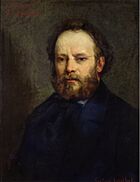
Many notable people were born in Besançon, including:
- Claude Goudimel (1510–1572), a musician.
- Antoine Perrenot de Granvelle (1517–1586), a cardinal and statesman.
- Jean-Jacques Boissard (1528–1602), an antiquarian and poet.
- Jean Mairet (1604–1686), a playwright.
- Charles Fourier (1772–1837), who came up with the idea of "phalansteries" (ideal communities).
- Charles Nodier (1780–1844), a writer and leader of the Romantic movement.
- Victor Hugo (1802–1885), a famous poet, playwright, and novelist.
- Pierre-Joseph Proudhon (1809–1865), a politician and writer, known for his ideas on anarchism.
- Hilaire de Chardonnet (1838–1924), who invented artificial silk.
- Auguste and Louis Lumière (1862–1954) and (1864–1948), who invented cinematography (moving pictures).
- Tristan Bernard (1866–1947), a journalist and humorist.
- Lucien Laurent (1907–2005), a footballer.
- Raymond Blanc (born 1949), a chef.
- Gaspard Augé (born 1979), one half of the electronic music duo Justice.
- King Willem-Alexander of the Netherlands (born 1967) is the Lord of Besançon.
Besançon's Sister Cities
Besançon is connected with these cities around the world:
 Bielsko-Biała, Poland
Bielsko-Biała, Poland Bistriţa, Romania
Bistriţa, Romania Charlottesville, United States
Charlottesville, United States Douroula, Burkina Faso
Douroula, Burkina Faso Freiburg im Breisgau, Germany
Freiburg im Breisgau, Germany Hadera, Israel
Hadera, Israel Kirklees, England, United Kingdom
Kirklees, England, United Kingdom Kuopio, Finland
Kuopio, Finland Man, Ivory Coast
Man, Ivory Coast Matsumae, Japan
Matsumae, Japan Neuchâtel, Switzerland
Neuchâtel, Switzerland Pavia, Italy
Pavia, Italy Tver, Russia
Tver, Russia
Images for kids
See also
 In Spanish: Besanzón para niños
In Spanish: Besanzón para niños


